Digital Modeling, Furnituremaking, and the Artist's Vision
A question about CAD and CNC for furnituremaking evolves into something much broader and deeper, as some extraordinary creative visualizations knock heads with some hard-bitten practical criticism. Technology versus Art: it's smackdown time for 12 full rounds. December 11, 2007
Question
Can someone explain the requirements to make 3D digital furniture to be used with CNC? My example shows two dressing tables. The second table was non-linear scaled and morphed to new shape from the original table size. Table #2 scaled and coped in 30 seconds. (xscale=.7 yscale= .6 zscale=1) Digital texture of leather, chrome, glass, and brass was used. Anyone here doing this type work?
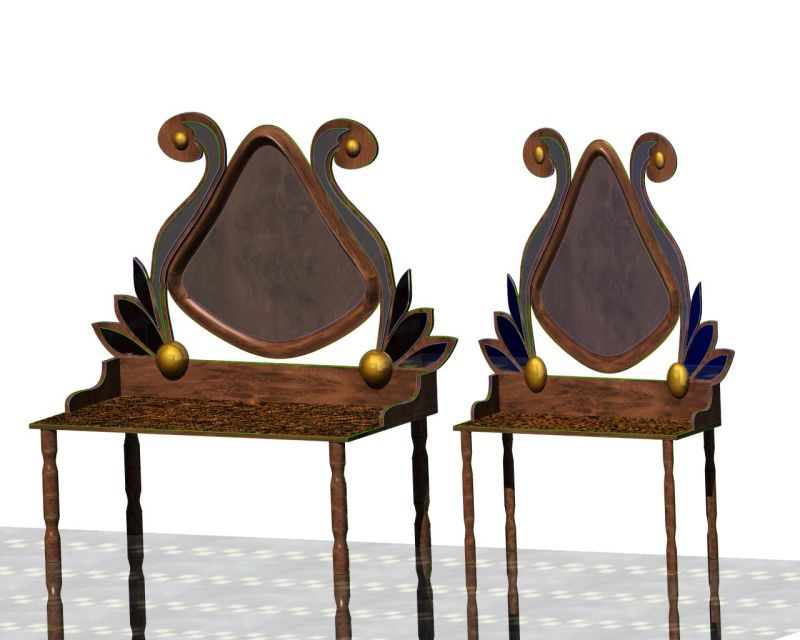
Click here for higher quality, full size image
Forum Responses
(Furniture Making Forum)
From contributor J:
A CNC machine requires a toolpath file. That is generated by software that starts with each individual 3D part and the size of the stock used to make the part.
But before getting that far ahead of yourself, you need to understand how furniture is made, and your drawings indicate a lack of that knowledge. I learned furniture design first by doing, then by studying it in college. Perhaps you can locate a program near you that will show you the entire process, from material selection to design, to milling the parts.
From the original questioner:
What do you see lacking in my 3D models?
From contributor T:
You may want to take a look at 3D Structsoft for furniture.
From contributor C:
You need to learn more than just digital drawing. Just because something can be digitally drawn does not mean it should be made. Most things will look hideous, and you don't have to go far to see an example. I'm not sure what you are trying to do, but your furniture as drawn shows little regard for the reality of building the pieces.
The world of CNC has struggled because it tries to posit itself as the solution to all woodworking issues. In reality, it is only the solution to some of the problems associated with cutting parts. The artisan's eye, hand, and brain play no part - as evidenced by the renderings above.
The Golden ratio and historical design are both very important. To ignore them is to create a bastard piece of furniture, with no historical or design perspective. Even the most contemporary, radical pieces of art furniture have historical references as well as proportion.
From the original questioner:
My question still stands. What are the requirements to make good CNC furniture? Is the math shape what you don't like about this example?
The 3D surface model database is good. What can 3D Structsoft for furniture do different than example shown? Automotive high-end 3D software used on example renderings.
From contributor G:
Your bureau (if that is what it is) needs a structural skirt or alternative framework underneath... stretchers? I'm envious of your drafting abilities, and CAD in general. It seems liberated. I still have to sketch with a pencil and eraser.
From contributor J:
Contributor G, computers are just another tool - like a pencil or pen and ink. I taught college level drafting and CAD drafting - trust me, anyone can do it. The key is to understand how things are made and to grasp basic aesthetics. Otherwise, it is just an expensive tool producing bad drawings.
If you are serious about learning CAD, try your nearest community college - the basic classes should give you an idea whether or not it is something you should consider in your professional life.
I have been using CAD since 1979, and I started studying furniture design at the same time. I create drawings and toolpaths for 2D and 3D parts every week. As I say, it's just another way to get the job done.
From contributor G:
I did ten fascinating years as a woodcarving instructor in a local art center (Bloomington, Indiana). This drawing fascinates me, contributor J, as much as your CNC carved wood bowl of a few years back. So, I'll confess... I'm the local copy lathe operator (so far), and a plastic template takes me two hours.
To the original questioner: I assert that this forum is perfect for your sort of artistic revolution, and I ask you to design and CNC mill a 1/4" plastic template for the legs of your design... openly, and on this forum, for everyone to learn and profit. I gladly offer my criticisms, and hope others will too, and offer to ultimately, and for free, run your program on my copy lathe.
From the original questioner:
Thanks for the kind words about a rough 3 hour modeling job. The example is just rough 3D sketch from a 2D picture. All digital 3D CAD/CAM design model artistic revolution is here for those who do it. My critics are many, but few can do as I show. The legs are not finished but will be lion paws.
From contributor R:
I think you might be taking some flack because of your design detail and your real question may be being missed. If you are asking what it takes to go from a 3D rendering to CNC machining a model or full size piece of your design, my opinion would be this... It would take a model maker or furniture maker with 5 to 10 years of hands-on experience, working with a young engineer that is savvy with "G" code and willing to listen to an older woodworker who will think he knows it all. You also need the ability to adapt the CNC machine, tooling, and fixtures to handle the designs and problems you encounter. Plus a lot of luck. We converted a 5 man model shop over a two year period and lived through what you are describing. Furnituremakers create a living making one of a kind beautiful pieces for their customers.
3D modeling and CNC machining are usually only practical for very high volume jobs. The design conversion and programming of a one time run are usually too expensive. Balance the costs of generating a 3D file and giving it to a laser or water jet prototype shop. Have them run it in wood and see the results. Or give a sketch to one of the furnituremakers responding to your posting and enjoy the results of years of experience.
Technology will get there someday, but right now the mechanical side is not as far ahead as the software side of the brain.
From contributor J:
The questioner is rightfully getting flack for the flagrant disregard of furniture design standards and esthetics that his renderings display.
The way to create G code or any other machine readable code was addressed in my first response. Use Visual Mill or a similar software package. It will read the model and create a tool path file or files specific to the CNC machine being used. That takes only a few minutes and the resulting toolpath can be used to mill the part. It is practical for a one off piece or a production run. The programs used to write toolpaths are self-explanatory. Furniture design, however, is not.
From contributor G:
Have I heard correctly that all I would have to do is make a split turning - Windsor chair leg - and trace around one of the halves, then that drawing is run through the (programmer's) scanner? This scanned tracing provides the data, via the 2D modeling software, for the program, that would result in a copy lathe template. I'd rather turn any number of sample turnings in search of the right one, and loathe the idea of putting a profile up on a screen (although I'm bound and determined to learn).
From the original questioner:
Notice scroll carving at bottom then morphed to different shape. Open up your mind and morph the data. All digital data ready for milling and production.
From contributor G:
Here is a picture of one of my previous efforts at chair making. I designed all parts using pictures of classic Windsors. I think my interpretations are rather liberal. I turned prototypes (long burned), and carved small model seats (also turned into heat). The rakish angles I consigned to memory. I doubt that I'll be able to retrieve those from that particular fire. See where I missed out by not getting into computers twenty plus years ago.
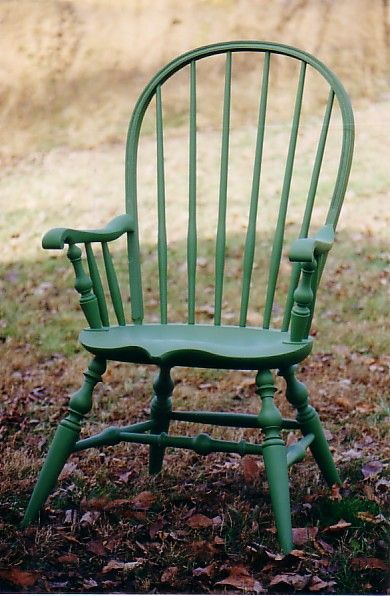
Click here for higher quality, full size image
From contributor J:
That is a very nice looking chair - is it a child's chair? You have certainly captured the spirit of a Windsor. The turnings are very crisp and dynamic. Well done.
From contributor P:
To the original questioner: With all due respect, it's tough to design furniture successfully unless you've built some. I looked on your website, and saw a lot of work done in wood that could have been cut out of any material, and nothing that really qualified as furniture, i.e. complex constructions involving multiple shaped parts joined together to form a pleasing whole. Your computer and milling skills appear to be fine, but there's more to it than that. I'm not saying this to be rude or demeaning, but you truly don't know what you are doing, and the design shows it.
For instance, you asked for comment on your scaling of the design. In the real world nobody scales a design like that, with every element resized. Wood comes in distinct thicknesses, so it doesn't make sense to treat the size of elements as infinitely variable. The size of elements in classic furniture design is closely related to standard stock thicknesses. So the professional approach to scaling is actually to make things bigger and smaller in steps, not as an overall construction. For instance, you might have a table leg turned from 2 3/4" square stock. If you are making the table longer, you just make it longer without resizing the legs, unless you are making it a lot longer, at which point you take the legs up to 3 3/4". Where is the point where you make the switch? That's the trick that only experience will teach.
I congratulate you on your desire to come up with new designs, but you will end up with a much better result if you spend some time examining the existing state of the art.
From contributor G:
Actually, this chair was built for a man who is heavy. Am I wrong in thinking that if I had a CNC program to machine the seat, I could scale it down for a child?
This next chair comes five years after the green Windsor, and I've since learned how to make templates. Much more organization (they hang on a nail).
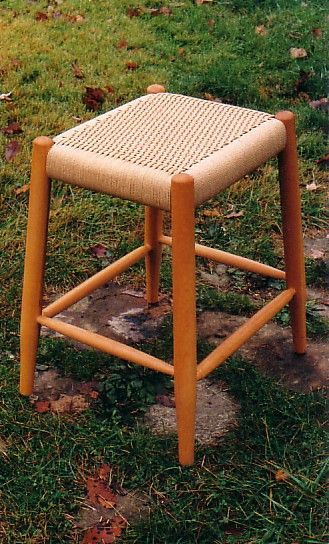
Click here for higher quality, full size image
From contributor M:
I think what some people here are trying to say is you just can't take a design and squeeze it to fit a new size. It just doesn't look right afterward. For example, I can make either one of these on our CNC. I wouldn't make the one on the right.
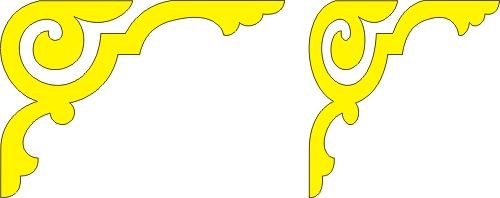
Click here for higher quality, full size image
From contributor G:
I disagree. I think either one of your wonderful drawings has tremendous potential, and that includes not only in the orientation shown. Yes, I looked at them upside down and sideways. I suppose you'd have proportion opinions, also, about the thickness of the machined material relevant to its location. A bracket underneath a porch at 11/4" thick, and the same design scaled down for a Victorian "whatever" at 1/2" thick, for example? You can play with proportion by adjusting the copy bar on any copy lathe. I might be a bit clunky, but I wouldn't want my furniture to look that way.
From contributor M:
I don't understand what you disagree with. And I will take criticism for or against. I tried to show that when you can squeeze a design, it might need to be redesigned to fit your new dimensions. As in the questioner's table. If the curves were adjusted, the piece would flow better.
From contributor G:
When I was an instructor, I'd do anything to get people to sketch. All I did was admire your drawings by themselves, not in relation to something else. Either one of them had imaginary potential to me. I'm hoping that the questioner will come back with another furniture design!
From contributor G:
I've had a memory! In order to get the bold turning look on my green Windsor, I lengthened the straight taper part of the leg and arm post turnings, decreasing the ornamental part of the turning length. Essentially, that information was compressed, like you've done to your drawing, contributor M. So, I turned several prototypes, and had to adjust things around.
From contributor M:
Now I understand. Unlike some CAD and CNC people, I draw all of my patterns by hand first, with a pencil. I also work with customers as they describe what they want whether it is gingerbread, a mantel, or furniture.
From contributor G:
Contributor J, it used to be artistic cannon that you could use the profile of a fruit or nut, which is always infinitely different, as the outside form of a container - in wood, clay, silver, whatever. Could you be persuaded to post the picture of the wood bowl which you designed in CAD and CNC routed? Contributor M, could you be persuaded to elongate and compress a turning profile and show it? I actually started with moulding profiles, which my students would interpret on the manual wood lathe.
From contributor G:
So, I designed this turning inspired by a young woman's photograph. Love that tracing paper and eraser. Can this drawing (of the turning) be compressed, expanded, distorted in CAD?
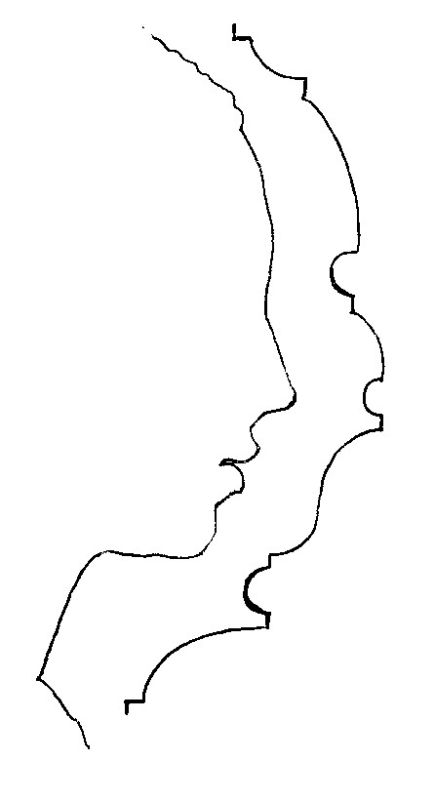
Click here for higher quality, full size image
From contributor M:
The blue one is to original scale. The red ones are stretched on the vertical only. The green ones are squeezed on the vertical only.
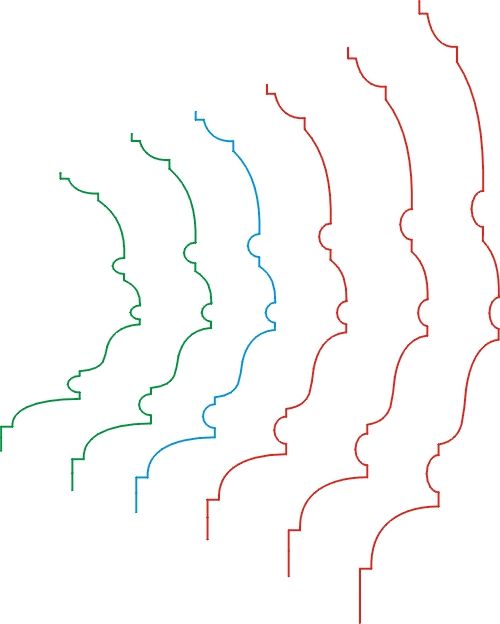
Click here for higher quality, full size image
From contributor J:
Take the outline(s), create a surface of revolution, then render the result - that, when using proper light sources, should give one an idea whether or not any of the lines should be turned in real life. By looking at them from various angles, you can also see which areas need to be adjusted.
From contributor G:
Contributor M, for an old school fool like myself, it would be a daunting task to get out the French curves, compass, etc., and do what you've done. This was a first for me, and I suspect many others, to see what you've drawn.
Contributor J, my CAD knowledge is miniscule, but I believe you've outlined a procedure to see these drawings in a more 3D format. I love that.
From the original questioner:
Contributor J's request... Here are the sections in 3D as well as morphed 3D parts.
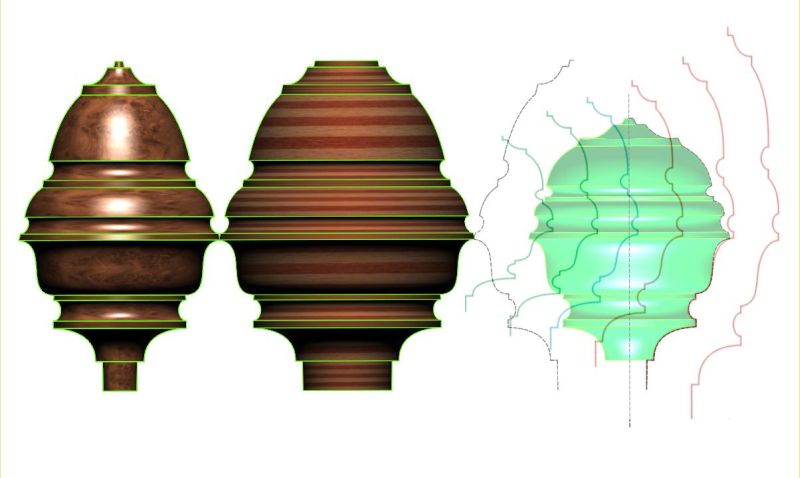
Click here for higher quality, full size image
From contributor G:
To the original questioner: Your drawing... a first for me. Although it's been flip-flopped (positive for negative), what do I care? Wonderful.
From contributor M:
To the original questioner: Great job. I know you were able to accomplish that with great ease. If I needed to show the turned profile to a customer for approval, I would have had to print it and shade it with a pencil. I prefer a 3b and 6b. So to summarize... We have shown how CAD can modify classical structure and how ancient methods are helpful for initial design.
From contributor G:
Straight out line drawings speak to me (my best critic) just fine. What I need is a quickie background that takes all the drudgery away, stuff like perspective and even classical composition.
From contributor J:
Some 3D design tools will automatically present an image with perspective included as part of the final rendering. Have you investigated local schools for classes in 3D design?
My point in this entire discussion has been that just because someone can design something, does not mean that the object should be created. That is where judgment and discernment come into play. The turnings based on a facial profile, while interesting, are not something that I would spend time turning - the results would not justify the effort. An experienced turner would change just about every aspect of the profile based on experience and esthetics, and ultimately, taking into account the use the turning would be put to. Is it a finial? A newel post? Different uses require different designs, and as it is, that design is sorely lacking in any redeeming values. An interesting exercise, certainly, but worth producing? I doubt it.
I hope this helps. It might be good to get some exposure to 3D design software - that would make many things a lot clearer. And if there is a local CNC shop that you can visit, that might be helpful too - see what the limits of the machinery are and what the strengths are.
From contributor G:
Well, actually, tomorrow I am going to a CNC job shop for a chair seat I've carved, and I can hardly wait to report back. Basically, my whole position is, the act of drawing and its personal relevance. The questioner never gave me permission to critique his drawing, and it wouldn't have mattered. No matter what he had said, any drawing of any quality is encouraged by me.
From contributor J:
I have over 50 years experience drawing. Do it constantly - every day. I have sketchbooks full of everything from furniture to turnings to life drawings. I also sculpted from life. Also studied pottery design and throwing on the wheel. I have made thousands of objects in my life, using whatever tools I had available at the time. But drawing is the basis for all design, at least for me.
As I said at the top - computers are just another tool - the way to learn is to do. So along with a lifetime of drawing my hand, I have nearly 30 years experience drawing using software of some sort - from printed wiring boards to integrated circuits to 3D mechanical design to bowls and housewares. I have also taken designs from software to my CNC and milled them.
I don't know which bowl you are talking about - I have made many, sold them or piled them in boxes around the house. But I think the bowl you are talking about is one I designed in Rhino and milled on my CNC. Rhino is the most intuitive 3D design tool I have used, and if you are serious about learning to use computerized tools, that might not be a bad place to start. I have also used Applicon, Calma, Cimlinc and AutoCad 3D packages, and several finite element analysis tools. Rhino is the most flexible I have encountered so far.
I like AutoCad for 2D layout work and have designed and milled many parts using that as a starting point. I also use Partwizard for signs and furniture part design and tool path generation.
I currently turn bowls full time and have over 300 of them lying around the house drying. There are design challenges every time you put a piece of wood on the lathe.
As for the rest... You have fantastic design skills and your work shows it. At best a CNC machine can reduce the amount of hard labor required to properly produce a nicely saddled Windsor chair seat. At worst, it could be frustrating as heck to get the bugs out of the software model - what the hand does instinctively when shaping a seat, the software will resist mightily. I speak from experience - a Windsor seat model will take a long time to sort out and many prototypes will have to be milled. On the other hand, you can take an existing seat and have it digitized - the probe can read a number of points from the physical piece and create a model which can then be adjusted by an astute operator in order to make a toolpath that can be used and scaled for various projects. But once again, it will depend on the skill of the operator - nothing is free, cheap, or easy. Look at mass produced furniture and that much will be obvious.
From contributor G:
So, I got back from the CNC job shop. They could program the chair seat, working from my full-scale model, for $200. They didn't like to give guesstimations because the program would give the cycle time depending on species (hardness). My, how they admired the picture of the green Windsor, and they just couldn't understand how a great craftsman like me could go starving. And they did bring up the minimum order cost, and on and on.






